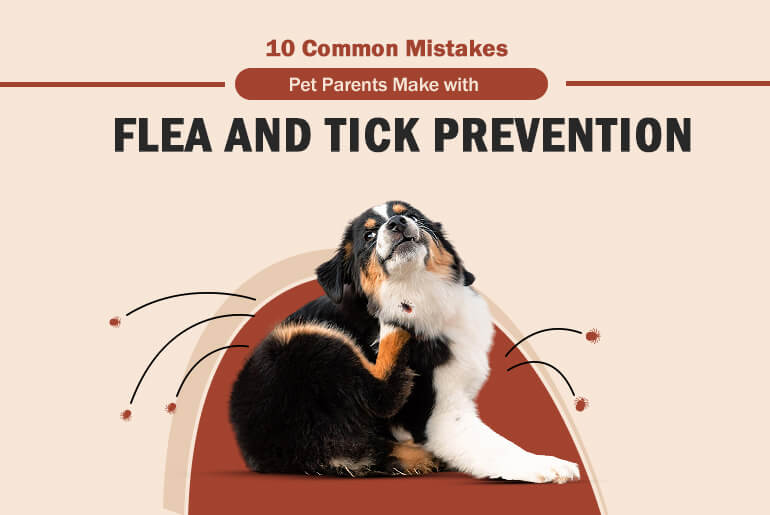This is to all devoted pet parents; you know that flea and tick prevention is more than just a seasonal issue – it’s a year-round responsibility. Yet, many dog parents unintentionally compromise their pet’s health when these tiny parasites do more than cause itching. They transmit diseases, lead to serious infections and even cause long-term damage like flea & tick-borne diseases, such as anemia, Lyme disease, etc.
So, what exactly are you as a pet parent getting wrong, and how can you stay ahead of the flea and tick infestations?
Let’s break it down, mistake by mistake.
1. Skipping Prevention During Winter
People believe that fleas and ticks vanish in colder places, but that’s not true. Fleas can very much survive indoors—on carpets, upholstery, bedding—and ticks become active above 4°C (around 40°F).
You should stick to year-round protection. Treatments that offer protection for a longer duration are perfect even during the off-season.
2. Assuming Indoor Pets are Safe
Believing your pet stays indoors so they don’t need protection is a big mistake. It doesn’t work like that. You could unknowingly bring pests into your house on your shoes or clothes. Once inside, fleas have the potential to reproduce at an alarming rate by laying 50 eggs a day.
This means that indoor pets need protection too! Talk to your vet about vet-approved oral or topical preventives that treat and kill parasites effectively.
3. Using the Wrong Dosage or Product
Giving a cat a dog’s flea pill or vice versa is dangerous. Treatments are tailored to species, weight, and age. Using the wrong one can cause side effects ranging from vomiting to seizures.
Always weigh your pet and choose the correct variant. Many vet-approved options come in weight-specific packs. And never use a dog product on cats unless the label explicitly says it’s safe.
4. DIY Treatments or Unregulated Products
From garlic pills to ‘natural’ oils, homemade remedies often lack scientific backing and can do more harm than good. The FDA has issued multiple warnings about unapproved flea products being toxic.
Stick to vet-approved products like Bravecto or Nexgard for dogs , which undergo clinical trials and offer proven safety and efficacy.
5. Not Treating the Environment
Treating only your pet is like mopping the floor while the tap is still running. Fleas tend to hide in carpets, shoes, upholstery, curtains, bedding and even cracks in the floor.
Regularly washing your pet’s bedding, vacuuming often and spraying or using environmental treatments helps in breaking the flea lifecycle and preventing re-infestation.
6. Ignoring Heartworm Prevention
Most pet parents separate flea and tick prevention from heartworm disease, but that’s risky. Mosquitoes transmit heartworm disease, and in many cases, combo preventives exist that tackle both.
Pro Tip: Opt for all-in-one solutions that simplify your pet’s routine while providing broad protection.
7. Inconsistent Application or Forgetting Doses
Flea meds only work if given consistently. Missing a month gives fleas a head start. And unlike humans, dogs can’t remind you when they itch. Use the auto-delivery feature or set reminders. If monthly dosing feels hard to stick to, consider longer-lasting options.
Pro Tip: You can also opt for Bravecto if monthly dosing is hard to stick with; it lasts up to 3 months per dose.
8. Bathing Right After Applying Topicals
If you’re using a spot-on product and bathing right after, you might be washing it off before it even has the time to absorb.
Always follow label instructions and a quick tip is to wait for 48-72 hours after applying most topicals before bathing.
Pro Tip: You can also switch to oral preventatives like NexGard for Dogs, which are unaffected by water.
9. Not Consulting Your Vet Before Switching Brands
Switching pet treatment brands without consulting your vet can result in ineffective, risky combinations, double-dosing or even allergic reactions.
This means you should always consult your vet when changing flea and tick treatments, especially if you’re introducing a new class of Pharmaceutical or a combo product. For example, if you’re moving from NexGard to Simparica, check for ingredient interactions or overlapping dosing schedules.
10. Thinking One Type of Parasite Means One Type of Solution
Some products only target fleas, while others protect against ticks, mites, and worms too. Assuming one-size-fits-all can lead to gaps in coverage.
Read product labels carefully. If you’re in a high-risk area or travel often, look for comprehensive solutions that cover a broad range of parasites.
On a Final Note,
Flea and Tick prevention is an act of love – but it’s one that demands consistency, attention to detail, and evidence-based action. Don’t fall for myths. Don’t get lazy in winter and please, don’t wait until your pet is itching or infected.
Whether it’s flea and tick season or not, protection never goes out of season. Ask your vet to guide you, understand your options, and make a smart, informed choice.





